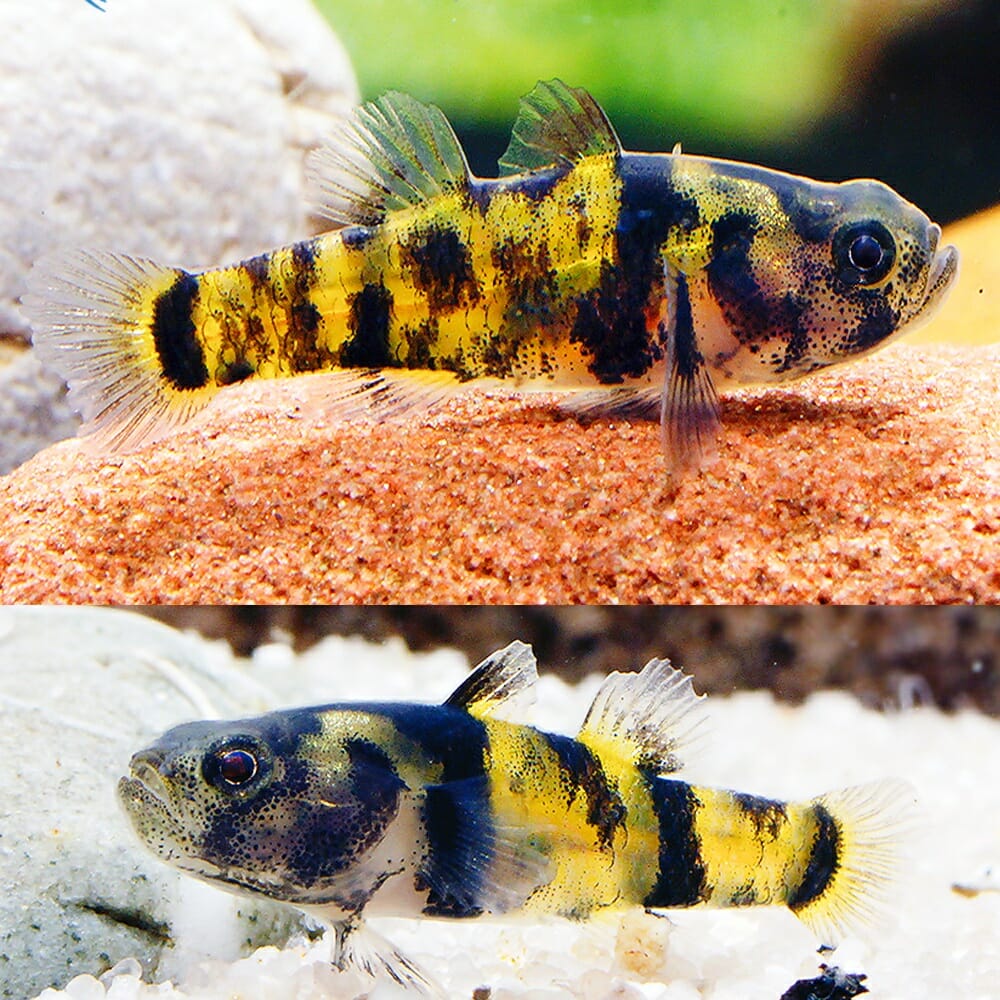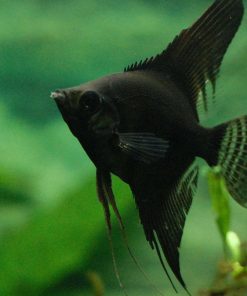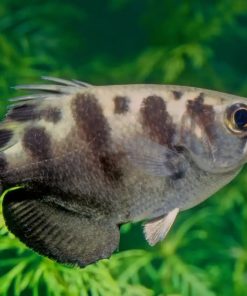Goby Bumble Bee Burmese Spotted Dwarf Aquarium Industries
$ 9,95 $ 5,97
For aquarists looking to keep a highly under-rated and oddball fish, the Burmese spotted goby is a perfect selection. These fish are a very rare find in the aquarium hobby and make for a great fish to keep in a nano display because of their small size, unique behavior, and colours. These spotted gobies are closely related to the common yellow and black bumble bee gobies which are popular fish to keep in brackish water aquariums however these spotted bumblebee gobies can thrive in full freshwater environments. Due to their lack of overall availability, there is a large lack of first had aquarist experience in regards to the care of these fish however they are reported to be fairly easy to keep despite their incredibly small size. The spotted bumblebee goby also has a very unique aesthetic when compared to other aquarium species, it has a small, stubby body that only reaches around 2 cm. Color-wise they have an almost translucent white colour with a hit of yellow at the name of their body, their most characteristic factor is the patterning of black striations and blotches through the body which is where they get their name from. Their small size also makes them a very peaceful fish that would be a great addition to a nano tank.
The Burmese spotted gobies are found through a broad demographic range starting from Laos (prior known as Burma) and going all the way to Thailand. They are considered to be tropical fish but can thrive in a varied temperature range from 22-28 degrees. These spotted gobies also come from locations where the PH is very acidic due to fallen leaves and organic matter in the tank so the recommended PH range would be anything from 4.5-to 6.0, this can be easily maintained through aquarium safe botanicals and hardscape selection such as driftwood.
Burmese spotted gobies would be the perfect fish to add to a very slow-paced nano community aquarium that emulates their wild blackwater setting. Breeding these is apparently possible however is a very difficult process because these fish do breed through specific environmental queues, in the wild their breeding behavior is usually triggered through temperature and seasons. Males are usually thinner whereas females can be a bit rounder, however, there are no obvious dimorphic factors in males and females.
Fast Shipping and Professional Packaging
Because of our long-standing relationship with UPS FedEx DHL as well as other leading global carriers, we can offer a variety shipping options. Our warehouse staff is highly skilled and will wrap your goods in accordance with our exact and precise specifications. Your goods will go through a thorough inspection and be adequately secured before being shipped. We ship to thousands customers every day from all over the world. This demonstrates our dedication to become the biggest online retailer in the world. Both Europe as well as the USA have distribution and warehouse centers.
Note that orders containing more than one item are processed according to the particular item.
Before shipping, we will inspect the ordered items thoroughly. Today, the majority of orders will be delivered within 48 hours. The delivery time is estimated to be between three and seven days.
Returns
Due to the multiple parties involved, including the factory and the warehouse, we're unable to completely manage our stock. Therefore, the actual inventory could change at any time. It's possible that the stock may run out after your order has been processed.
Our policy is for 30 days. If you don't receive your product within 30 days, we are not able to issue a refund or an exchange.
Your item should be in its original packaging and in good condition. It must also not be used. The item must be returned in the original packaging.
Related products
Freshwater tropical fish
Freshwater tropical fish
Freshwater tropical fish
Freshwater tropical fish
Angelfish Rio Nanay Peru Altum F1 5cm Bundarra Tropical Fish Farm
Freshwater tropical fish
Freshwater tropical fish
Freshwater tropical fish
Freshwater tropical fish
Freshwater tropical fish
Freshwater tropical fish
Apistogramma – Cacatuoides Mega Orange PAIR Bundarra Tropical Fish Farm
Freshwater tropical fish
Freshwater tropical fish
Freshwater tropical fish
Freshwater tropical fish
Freshwater tropical fish
Apistogramma – Agassizii Double Red PAIR Bundarra Tropical Fish Farm
Freshwater tropical fish
Freshwater tropical fish
Freshwater tropical fish
Freshwater tropical fish
Freshwater tropical fish
Freshwater tropical fish
Freshwater tropical fish
Angelfish Bulgarian Seal Point 4cm Bundarra Tropical Fish Farm
Freshwater tropical fish
Freshwater tropical fish
Freshwater tropical fish
Angelfish Red Devil 4cm (A Grade) Bundarra Tropical Fish Farm
Freshwater tropical fish
Apistogramma – Viejita Red Edge PAIR Bundarra Tropical Fish Farm
Freshwater tropical fish
Freshwater tropical fish
Freshwater tropical fish
Freshwater tropical fish
Freshwater tropical fish
Freshwater tropical fish










































